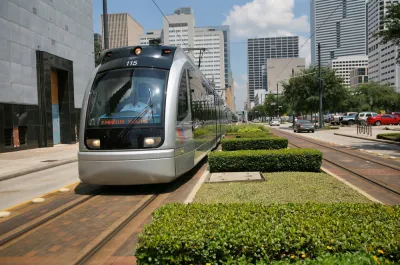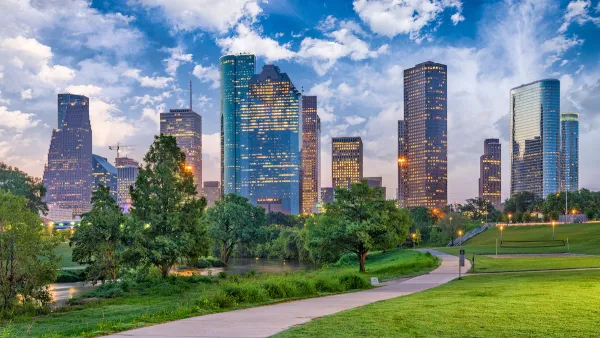Finally, the city seems to be reaping benefits from a major investment in public transportation.

Light rail has been an important (and expensive) part of urban development in both Dallas and Houston, two cities better known for sprawl than vibrant density.
In Houston, at least, two recent studies show that rail was a sound investment, notes Dian Nostikasari at Rice University’s The Urban Edge.
The first, from Texas Southern University, concluded, “[T[here have been measurable positive impacts from the development of light rail, at least on the Main Street corridor.”
The second, from one researcher with the Washington State Department of Transportation and another from the Texas A&M Transportation Institute, “examined changing land use within approximately half-mile of the rail stations along the original red, purple and green line in Houston.”
“That study found that along the original red line, there was a rise in commercial development that happened after the light rail came in but that began even before the red line was constructed. The study also found, increased development on vacant lands along these rail lines. This is a good thing as vacant land in cities like Houston tends to represent a lack of investment. Even as the Houston region continued to face a shortage of affordable housing supply, residential units along these rail lines increased – a trend across the country as living close to transit becomes a more attractive option.”
After many years of resistance to investing in public transit, light rail in Houston has been well received, as has the city’s investment in the bus system; together they represent a cultural and bureaucratic shift towards “walkable urbanism” in the city that doesn’t zone.
“Houston continues to grow but is at a crossroads post-Harvey,” Nostikarari writes. “Can it afford to continue growing as before and face the long-term consequences of being a car-dependent, outward growing metropolis? Or must it begin to think about prioritizing growing inward by improving its public transportation infrastructure and putting work places and other important destinations close to where people live while ensuring residents
FULL STORY: HOUSTON STUDIES SHOW LIGHT RAIL DID BRING SOME BENEFITS

Analysis: Cybertruck Fatality Rate Far Exceeds That of Ford Pinto
The Tesla Cybertruck was recalled seven times last year.

National Parks Layoffs Will Cause Communities to Lose Billions
Thousands of essential park workers were laid off this week, just before the busy spring break season.

Retro-silient?: America’s First “Eco-burb,” The Woodlands Turns 50
A master-planned community north of Houston offers lessons on green infrastructure and resilient design, but falls short of its founder’s lofty affordability and walkability goals.

Test News Post 1
This is a summary

Analysis: Cybertruck Fatality Rate Far Exceeds That of Ford Pinto
The Tesla Cybertruck was recalled seven times last year.

Test News Headline 46
Test for the image on the front page.
Urban Design for Planners 1: Software Tools
This six-course series explores essential urban design concepts using open source software and equips planners with the tools they need to participate fully in the urban design process.
Planning for Universal Design
Learn the tools for implementing Universal Design in planning regulations.
EMC Planning Group, Inc.
Planetizen
Planetizen
Mpact (formerly Rail~Volution)
Great Falls Development Authority, Inc.
HUDs Office of Policy Development and Research
NYU Wagner Graduate School of Public Service




























